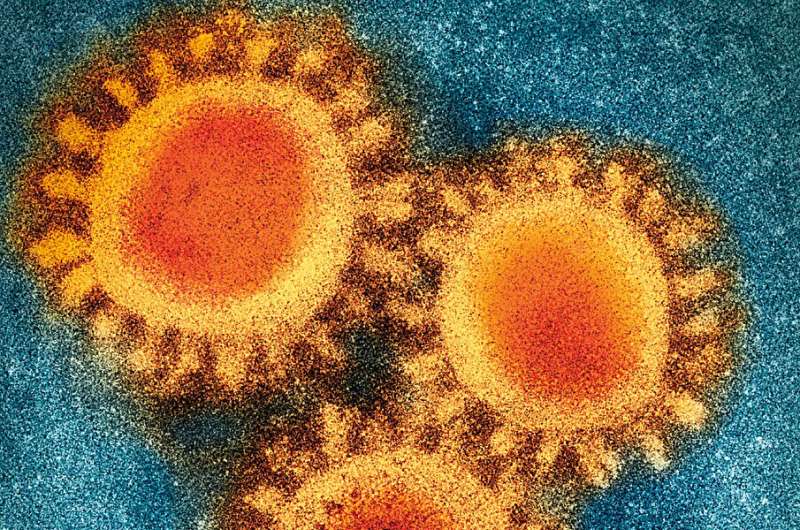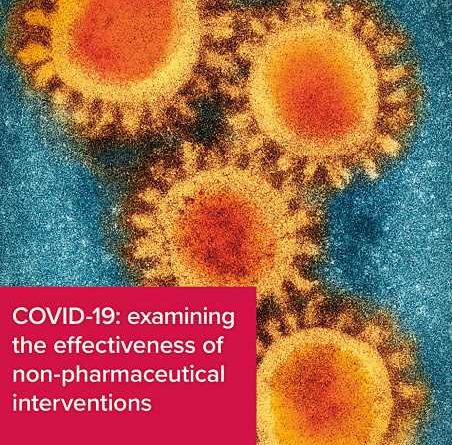Report: Combining public health measures kept us safe from COVID-19

Non-pharmaceutical interventions (NPIs), when applied in packages that combine a number of measures with complementary effects, were unequivocally effective in reducing the spread of infections during the COVID-19 pandemic, a major Royal Society report has found. NPIs are measures that are not drugs or vaccines aimed at reducing transmission of an infectious disease.
The report, “COVID-19: examining the effectiveness of non-pharmaceutical interventions,” reviewed the scientific evidence gathered during the pandemic for six groups of NPIs and their effectiveness in reducing transmission of the SARS-CoV-2 virus: masks and face coverings; social distancing and lockdowns; test, trace and isolate; travel restrictions and controls across international borders; environmental controls; and communications.
It found, when assessed individually, there was positive—if limited—evidence of transmission reduction from many of the NPIs used in the pandemic. However, the evidence of an effect was clear when countries used combinations of NPIs, and a small number of nations and regions were able to contain cases at very low numbers for up to the first 18 months of the pandemic.
Additionally, evidence showed NPIs were most effective when the intensity of transmission was low, supporting their use early in a pandemic and at first sign of resurgence.
NPIs are typically the only controls available in the early stages of responding to an emerging infectious disease, before the development of drug treatments, vaccines, and other therapies. However, as was seen around the world during COVID-19, their use can have adverse personal, educational, and economic consequences—making robust assessment of their effectiveness essential.
Professor Sir Mark Walport, Foreign Secretary of the Royal Society and chair of the report’s expert working group, said, “COVID-19 was the first global pandemic in human history where the use of non-pharmaceutical interventions bought time for the development of effective treatments and vaccines that saved many lives.
“This report seeks to answer important questions about which NPIs helped limit infections, and in what circumstances?
“There is sufficient evidence to conclude that early, stringent implementation of packages of complementary NPIs was unequivocally effective in limiting SARS-CoV-2 infections. That does not mean every NPI was effective in every setting, or at all times, but learning the lessons from the wealth of research generated in this pandemic will be key to equipping ourselves for the next one.”
The report draws together the findings of six expert-led evidence reviews, published today (24 August) in a special themed issue of the peer-reviewed journal Philosophical Transactions of the Royal Society A.
These reviews examined thousands of published studies, and applied rigorous inclusion criteria to identify papers that were suitably robust for inclusion in each review category. While a small number of randomized controlled trials (RCTs) were conducted during the pandemic, the majority of evidence available comes from observational studies.
Using observational data does influence the certainty of conclusions that can be drawn from the reviews, but the report concludes clear signals of effectiveness can be seen from the numerous, high- quality, rigorously conducted observational studies included.
Key findings from the report include:
- Social distancing and “lockdowns”—These were the most effective category of NPIs. Stay-at-home orders, physical distancing, and restrictions on gathering size were repeatedly found to be associated with significant reduction in SARS-CoV-2 transmission, with more stringent measures having greater effects. In care home settings, measures like cohorting and visitor restrictions were associated with reduced transmission and reduced outbreaks. In school settings, closures and other distancing measures were associated with reduced COVID-19 incidence, but the effectiveness varied depending on a range of factors, including adherence and pupils’ age.
- Facemasks and mask mandates—Studies consistently, though not universally, reported that mask wearing and mask mandates were an effective approach to reduce infection. There is also evidence, mainly from studies in health care settings, that higher-quality “respirator” masks (such as N95 masks) were more effective than surgical-type masks.
- Test, trace and isolate—Studies from several countries that implemented high levels of contact tracing, with isolation of infected individuals and their contacts, found reductions in COVID-19 deaths. Strong evidence was also found for the effectiveness of contact tracing apps. A trial of the U.K.’s app (alongside communications and manual tracing interventions) on the Isle of Wight was associated with a substantial reduction in transmission.
- International border control measures—Observational evidence from national case studies showed comprehensive border control policies could reduce, but not eliminate, the number of infected travelers entering the country. Based on the available evidence, quarantine at entry borders was found to have the highest levels of effectiveness. Whereas, symptomatic or exposure-based screening, including temperature screening before travel, was found to have had no meaningful effect on reducing importation or transmission.
- Environmental controls—There was evidence that enhanced ventilation, air treatment and reduced room occupancy did reduce transmission within particular settings. However, these measures were typically applied in combination with other NPIs, so accurately and individually quantifying their effectiveness was not possible.
- Impact of communication in the U.K. on uptake of NPIs—The limited evidence confirmed that communication was sufficiently effective to ensure high adherence to NPIs, it also identified the characteristics that led to non- or less-rigorous adherence.
For the future, the report recommends establishing international protocols for conducting RCTs and observational research on NPIs in advance of further pandemics. This would greatly improve the ability to evaluate the consequences of differences in implementation internationally and help to disaggregate their effects on different social groups and demographics.
Future research plans should also consider the costs as well as the benefits of NPIs, in terms of their impacts on livelihoods, economies, education, social cohesion, physical and mental well-being.
More information:
Leah Boulos et al, Effectiveness of face masks for reducing transmission of SARS-CoV-2: a rapid systematic review, Philosophical Transactions of the Royal Society A: Mathematical, Physical and Engineering Sciences (2023). DOI: 10.1098/rsta.2023.0133
Caitriona Murphy et al, Effectiveness of social distancing measures and lockdowns for reducing transmission of COVID-19 in non-healthcare, community-based settings, Philosophical Transactions of the Royal Society A: Mathematical, Physical and Engineering Sciences (2023). DOI: 10.1098/rsta.2023.0132
Hannah Littlecott et al, Effectiveness of testing, contact tracing and isolation interventions among the general population on reducing transmission of SARS-CoV-2: a systematic review, Philosophical Transactions of the Royal Society A: Mathematical, Physical and Engineering Sciences (2023). DOI: 10.1098/rsta.2023.0131
Karen Ann Grépin et al, Effectiveness of international border control measures during the COVID-19 pandemic: a narrative synthesis of published systematic reviews, Philosophical Transactions of the Royal Society A: Mathematical, Physical and Engineering Sciences (2023). DOI: 10.1098/rsta.2023.0134
Anagha Madhusudanan et al, Non-pharmaceutical interventions for COVID-19: a systematic review on environmental control measures, Philosophical Transactions of the Royal Society A: Mathematical, Physical and Engineering Sciences (2023). DOI: 10.1098/rsta.2023.0130
Simon N. Williams et al, Effectiveness of communications in enhancing adherence to public health behavioural interventions: a COVID-19 evidence review, Philosophical Transactions of the Royal Society A: Mathematical, Physical and Engineering Sciences (2023). DOI: 10.1098/rsta.2023.0129
Journal information:
Philosophical Transactions of the Royal Society A
Source: Read Full Article
